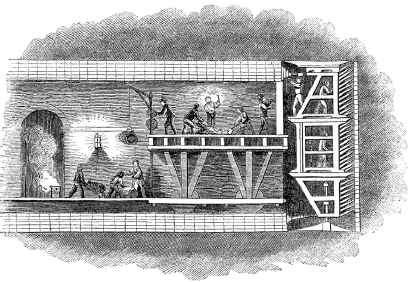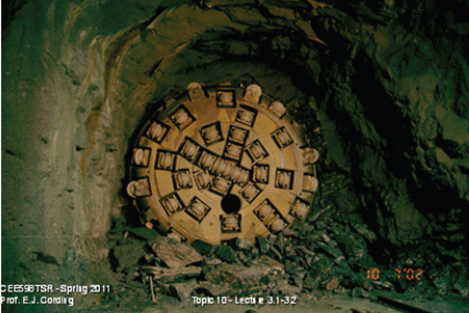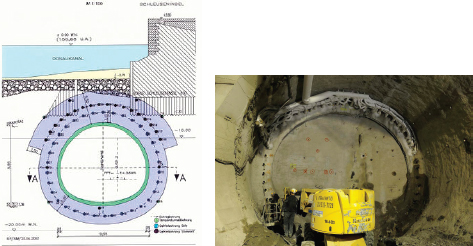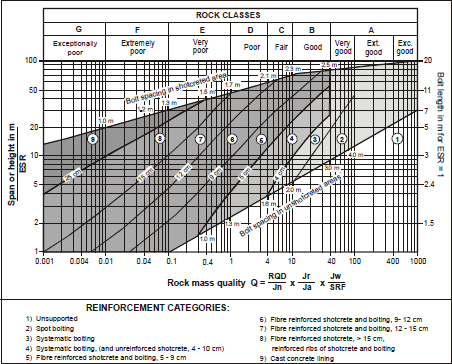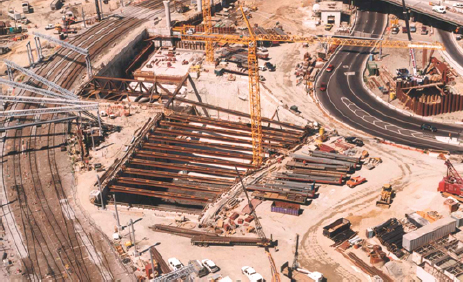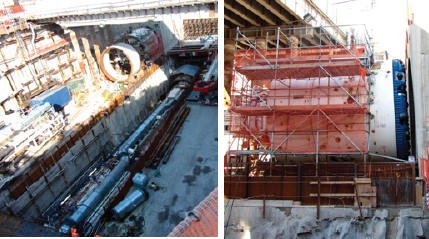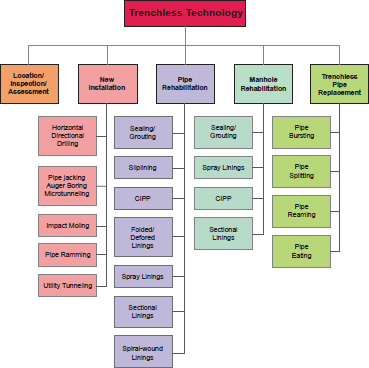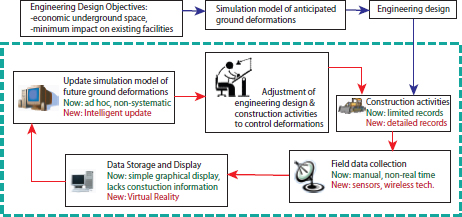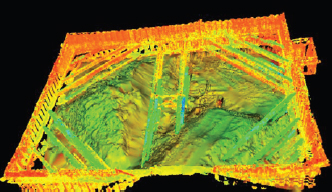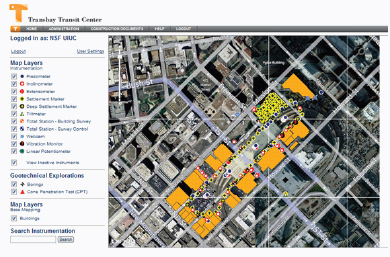Innovative Underground Technology and Engineering for Sustainable Development
Geotechnologies and related science and engineering fields make it possible to use underground space to support livable, resilient, and sustainable cities. Geotechnical applications have supported the design and construction of underground facilities, and will continue to be critical to the delivery of underground facilities with lower initial costs and risk, and better lifecycle performance. To contribute to a more resilient and sustainable future, geotechnology will need to more closely integrate the many disciplines related to site investigation, design, construction, operation, and risk management of underground facilities. A better understanding of the sustainability of underground use—for example, minimizing deterioration, increasing resilience, making holistic decisions concerning subsurface hydrogeologic and thermal environments—also will be necessary. Improvements in underground technologies have enabled great strides in urban development in recent decades, but the complexity and unpredictability still inherent in underground construction are indications that many challenges remain.
This chapter provides a brief overview of the state of the art in various technologies that support underground construction and facility operation. Highlighted are technologies that provide opportunities for significant improvement in the delivery of cost-effective lifecycle performance for underground facilities, contribute to improvements in underground space usage, and contribute to resilient and sustainable urban solutions.
Technological innovation can advance engineering practice and increase the appeal of underground space. Technological and engineering advances have always been crucial to efficient and economical underground development. Many technological developments have been motivated by practical challenges encountered during construction of a project (e.g., the development of the tunnel shield by Brunel), and the tunneling industry has contributed to or been instrumental in many of these. The highly automated modern tunneling boring machine is an example of an an industry led development as are water proofing and ground improvement technologies that have been introduced and popularized. In close partnership with academia, industry has developed many analysis and design tools (e.g., finite element analysis methods).
Since the time of the Pharaohs, tunnels have been built by cut-and-cover construction methods (El Salam, 2002). The invention of the tunnel shield—which supports unlined ground to reduce the risk of collapse, Sir Marc Isambard Brunel and his son Isambard Kingdom Brunel were able to excavate a tunnel under the Thames River (London) between 1825 and 1843 (Muir Wood et al., 1994; Skempton and Chrimes, 1994) (see Figure 6.1 for a drawing of Brunel’s shield). Previous projects involving tunnel boring in soft, saturated soils had been extremely difficult or impossible to complete. The tunnel created an important connection between the north and south banks of the Thames that is still in use almost 170 years later. The application of this new technology heralded the era of shield tunneling.
Electrically powered locomotives ushered in the era of modern subway systems around the turn of the twentieth century. Electrification alleviated concerns about hazardous diesel or coal fumes and allowed long-distance underground train travel. Innovations in large-scale ventilation systems permitted underground roadway development. Climate control systems, improved lighting, and more effective signage made the underground environment more hospitable, comfortable, and appealing for retail functions and mass transportation. Advances in materials technology, computer science, robotic construction technology, and laser guidance have allowed improved subsurface excavation using modern slurry shield and earth pressure balance boring machines1 (Figure 6.2) and rock tunnel boring machines (Figure 6.3). Those technologies made it feasible to construct tunnels exceeding 50 kilometers in length and at diameters approaching 20 meters, and to tunnel under challenging geologic conditions (e.g., in soft flowing ground or highly fractured rock under high ground and water pressures). Ground modification technologies—e.g., injecting cementitious agents to strengthen and reduce permeability of soil and rock, or temporarily freezing of water-bearing
_______________________
1 Slurry shield and earth pressure balance boring machines for boring in saturated soils are designed to withstand water under pressure.
FIGURE 6.1 Brunel’s tunnel shield. Marc Isambard Brunel developed this tunnel shield technology to build the first subaqueous tunnel beneath the Thames River (1821-1825). Brick walls were built at the faces of the tunnel and held in place while alternate shields were pushed forward 6 inches. The completed tunnel was 38 feet wide and accommodated two carriageways. SOURCE: http://en.wikipedia.org/wiki/File:Thames_tunnel_shield.png (accessed June 27, 2012). Public Domain.
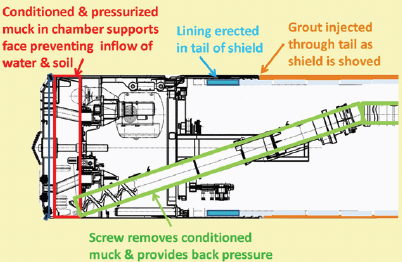
FIGURE 6.2 Cross-section of earth pressure balance tunnel boring machine. This tunneling technology is ideal for homogenous soft soils. A screw conveyor is used to transport spoil from the face and helps to control pressure with the coordinated advancement of the machine. The excavation chamber is filled to support the face and allow the machine to be reactive to earth and groundwater pressures. SOURCE: E.J. Cording.
FIGURE 6.3 Cutter head of a rock tunnel boring machine used to excavate the Chattahoochie tunnel. Disk cutters cut grooves approximately 4 inches apart in this example. SOURCE: E.J. Cording.
materials (Figure 6.4)—broadened the geologic and hydrologic conditions under which underground construction may occur. Horizontal directional drilling revolutionized installation of many utilities and greatly reduced the need to close streets to traffic and disrupt life in urban situations.
Many of the technologies described above led to changes in engineering practice, and in some cases, to new paradigms in urban planning. Similarly, today’s engineering and technology developments will be crucial to an economically constructed, functional, attractive, energy efficient, and sustainable urban environment. This chapter is grouped under the following themes:
• technologies for underground site characterization, including geologic setting, rock and soil properties, and existing underground infrastructure;
• technologies for design and analysis for underground technologies;
• technologies for construction of underground space;
• technologies for effective asset management; and
• technologies that promote sustainability and resilience.
These themes are not necessarily sequential or independent. Observations made during the application of each may inform decision making during any phase of development or operation. Infrastructure design may identify further site characterization needs, and unanticipated conditions encountered during construction
FIGURE 6.4 Artificial ground freezing is applied in the excavations extending under the Danube River. Freezing groundwater around an excavation improves the load carrying capacity of the soils and provides temporary support during construction. (Left) A crosssectional diagram with the locations of the freezing pipes indicated. SOURCE: IMWS, 2009. Reprinted with permission. (Right) Photograph showing excavation with freezing pipes in place. SOURCE: http://www.tunneltalk.com/images/BudapestMetro/6-Budapest-Metro-GroundFreezingApplied.jpg.
may require revisions in design. Monitoring and characterization ideally should occur throughout the infrastructure life cycle. Observations can lead to a type of informed decision making called observational method (e.g., Peck, 1969; Institute for Civil Engineers (Great Britain), 1996) that can improve economy and safety. Many geotechnical engineers refer to the framework for this method originated by Peck and described in a publication by Nicholson and others (1999).
The discussions within each theme are illustrative of technologies in use or that have significant potential for the future. By their nature, disruptive technologies are difficult to anticipate, but can fundamentally shift the way underground space is developed and used. Many of the technologies described in this chapter depend on the use of the observational method for effective decision making. Suggested are technologies for analyses that allow improved application of the observational method.
TECHNOLOGIES FOR UNDERGROUND SITE CHARACTERIZATION
Engineering urban underground space requires detailed knowledge of the underlying geology and the geologic and human-development histories of a site, alignment, and adjacent areas that may affect or be affected by proposed development. Better subsurface characterization supports better decision making. Minimizing
unanticipated ground conditions may allow optimized design and more judicious use of resources during construction. Detailed understanding of how the site relates to the broader natural and urban systems allows more complete understanding of the existing engineering challenges and informs underground infrastructure locations and alignments, design, choice of construction methods and tools, and long-term operation of the facility and adjacent structures.
Site characterization activities often begin through study of existing data and published information. Currently, relevant information must be gathered from many sources and may not provide adequate—or accurate—information about the geological setting or existing underground structures. Ongoing advances in computational capabilities (e.g., massive database systems, data mining) and georeferencing of data (e.g., survey-grade global positioning systems and geographical information systems) could be of great use in the future. These issues are further explored later in this chapter.
Characterizing Geology, Geologic Material Properties, Contamination, and Natural Hazards
A geologic perspective in site characterization is necessary to appreciate, quantify, and manage uncertainties in and variability of soil and rock properties and behavior (e.g., composition, stress-strain behavior, permeability, abrasivity, thermal conductivity) and groundwater conditions, ultimately minimizing costs or avoiding overly conservative design (NRC, 2006; FHWA, 2009). Preliminary field and laboratory work supports preliminary project design and construction planning, but further characterization narrows uncertainties and provides detail on important geologic features (e.g., boundaries of geologic units, fault zones), supports design of specific underground works (e.g., shafts, rooms), and provides information related to other special requirements (e.g., avoiding environmental contamination or in situ stress evaluation). The natural underground environment is inhomogeneous, anisotropic, and highly variable over short spatial extents. Large volumes of geologic material often must be characterized in great detail to detect stratigraphic changes and discontinuities important for predicting ground response to construction. A broad range of invasive and noninvasive technologies and tools are available to carry out in situ field investigations (see for example, FHWA, 2009), but existing assessment tools cannot provide complete spatial coverage, accurate zonation, and in-situ material properties.
At a project scale, hazardous materials encountered during underground construction can add large and unexpected costs to a project and delay project delivery. Characterizing natural and anthropogenic hazardous materials (e.g., chemical contamination and radiation) and their effects on the natural and built environments for particular construction and operation activities is vital. Understanding any hazardous materials that may be released or transported as a result of construction and operation is important to long-term sustainability and resilience.
Similarly, identifying adequate design approaches to protect underground infrastructure from natural hazards such as earthquakes or floods is critical to a resilient and well-functioning underground facility. Because these topics have a broad connection to sustainability and resilience, their characterization is discussed later in the chapter.
Environmental concerns that extend to underground storage and disposal also need to be considered. For example, society is grappling with the risks associated with the emerging technology of carbon dioxide sequestration. As more largescale sequestrations are planned, the need to examine their potential impacts on the ability to develop underground space becomes even greater, because, for example, carbon dioxide could seep into underground space. Therefore, the solution of one problem could inadvertently result in another problem. A recent NRC report explored the risk associated with induced seismicity as a result of carbon capture and storage and makes specific research recommendations related to, for example, factors other than pore pressure that influence seismicity, and development of physiochemical and fluid mechanical models for carbon dioxide injection into potential underground storage reservoirs (NRC, 2012).
Choice of characterization tools depends on a number of factors including depth of interest and ground conditions (e.g., soil versus rock; saturated versus partially saturated). Both traditional in situ technologies (e.g., direct measurement) and noninvasive technologies (e.g., geophysical) can be used to characterize natural and manmade features. Some construction sectors provide guidance on site characterization technology choices through extensive lists of tools and techniques (e.g., FHWA, 2009). Training and experience in the proper use of the tools, however, is usually as critical as the choice of technology itself.
Invasive Technologies
In situ testing tools provide direct physical measurement of material properties. In soils, for example, standard penetration tests and cone penetrometer tests (e.g., electric, piezocone, and seismic tools) are used to sample or test soil layers directly by drilling or thrusting sampling tools into the ground. Rock sampling and testing can be borehole based or conducted on the removed core. Borings are used to characterize properties such as soil strength, stiffness, dynamic shear wave velocity, and groundwater properties and quality, and the geology at the borehole location. An individual boring may or may not represent the subsurface only a short distance away given the potential variation in geology. Directionally inclined and horizontal boreholes and oriented probing tools also can be used to investigate specific features or the distribution of materials. Horizontal probing allows exploration of the subsurface along the length of the alignment of a tunnel or other infrastructure. The use of oriented exploration tools, while common in the energy exploration industry, is less common for civil underground structure development. This may be due to cost, but perhaps also to unfamiliarity with the technique among site investigation professionals. It may be argued that incentives
for efficiency are less evident for engineers than for contractors and owners who realize savings from efficiency.
Recent developments in boring technologies include cryogenic drilling capabilities for boring in difficult materials and measurement while drilling (MWD) systems that provide early information on the materials useful for guiding future borings and planning an efficient testing program. The profession has yet to widely adopt these techniques.
Noninvasive Technologies
Noninvasive site characterization tools include remote sensing (e.g., satellite and terrestrial light detection and ranging (LIDAR), digital photogrammetry, radiometric technologies, and interferometry methods) and ground geophysical techniques (e.g., seismic refraction and reflection, spectral analysis of surface waves (SASW), crosshole tomography, geoelectric, electromagnetic, and potential field methods [gravity, magnetic]) that provide data from which subsurface conditions may be inferred. Noninvasive techniques are best used in combination with invasive techniques to provide a more complete understanding of underground conditions. Advantages of noninvasive technologies are the speed with which they can be used and that larger volumes of the subsurface can be characterized. Disadvantages are that data generally must be reduced from their raw form—inversion modeling is often required to evaluate ground zonation and materials properties. Such models are non-unique (e.g., a single data set can yield infinite models), and hence special skills and knowledge are required to reduce and interpret data. The cost of some of these methods can also be high, but as the methods become more common and the technologies continue to improve (e.g., laser scanning), the cost of data acquisition and analysis will go down.
There is significant opportunity to improve data gathering related to ground properties and the presence and location of existing structures using noninvasive technologies, but there are physical limitations in terms of the scale of objects to be characterized and the material property differences that can be identified relative to the depth of investigation possible. There is, for example, a practical limit for pipe detection using surface-based ground penetrating radar (GPR), reported to be the ratio of approximately 12:1 for the detection depth to the detectable pipe diameter, even under favorable soil conditions (Sterling et al., 2009). This means that a 1-foot diameter pipe can only be detected if within 12 feet of the surface, and a 1-inch pipe can only be detected up to a depth of 1 foot. Research into the fusion of multi-sensor data that would allow noninvasive technologies to accommodate a wider range of ground conditions and to improve their ability to resolve ground properties and the presence and location of buried objects is under way both in the United States and overseas. Similarly, research by the military into the detection of land mines and deep covert tunnels can have significant benefits in broader civil engineering applications.
Characterizing Existing Infrastructure and Legacy Construction Materials
Failing to locate existing infrastructure before repairing existing or installing new infrastructure is a potential source of accidents. Legacy construction materials, including unmapped abandoned piles, foundations, or tiebacks that once provided support during previous construction, are regularly encountered during underground construction. Identifying and characterizing these artifacts is a necessary part of site characterization. Historical records found in planning departments can be used to identify locations of some legacy materials, but the records are often incomplete, inaccurate, or missing, thereby necessitating a greater reliance on exploration technologies, especially noninvasive, for characterization.
Unmapped or inaccurately mapped underground infrastructure poses potential hazards and risks for underground construction workers, the construction site, other infrastructure, and other people in the vicinity. Encountering unexpected infrastructure may necessitate revised construction planning or repairs. Existing or legacy infrastructure may be avoided, but sometimes must be protected with support designed to avoid displacement or damage to existing or planned infrastructure. The committee notes that every open-cut excavation, bore, or tunnel is an opportunity to assess and document the ground properties and structures encountered for present and future applications. The hundreds of thousands of open-cut excavations for utility work made every day in the United States, for example, offer repeated opportunities to collect and archive such data. However, the fidelity of nonivinasive techniques to identify subsurface infrastructure needs to be improved. Additionally, investigation technologies need to be integrated with new physical tools and administrative structures to capture this type of information. Mechanisms that allow dynamic archiving (e.g., continuous updating and modification) of these data are critical to the sustainability of urban infrastructure.
Interpreting and Integrating Site Characterization Data
Site characterization information and data must be processed and evaluated to develop interpretative geologic models and to generate the engineering parameters to be used in underground facility design (see examples in Box 6.1). Many field techniques used for preliminary property classification have been applied for decades and are subject to gross differences in interpretation. Typically, field classification cannot substitute for laboratory verifications. Many tools aid interpretation of, for example, rock classification including empirically based procedures such as the Q-system (for rock quality classification) (Barton et al., 1974), the Rock Mass Rating system (Bieniawski, 1976, 1989), and the Geological Strength Index (Hoek, 1994) (see Figure 6.5 for example classification). Classification schemes for characteristics such as strength and stiffness also are used to establish the input for advanced numerical analysis procedures.
Three-dimensional Geologic Modeling
Three-dimensional modeling of ground conditions that incorporate geotechnical and geophysical data is conducted extensively in the United States for development activities including resource exploration and extraction and infrastructure development. Similar modeling techniques can be applied to urban infrastructure planning, risk modeling, and resource management as is done by the British Geological Survey (see Figure 1). Such models can provide multiple “views” (e.g., orientations), be “exploded” (e.g., layers can be visually separated to isolate specific features or units), and otherwise manipulated to identify predicted physical properties at depth, the locations of anthropogenic structures, aquifer vulnerabilities, and other qualities. Such comprehensive
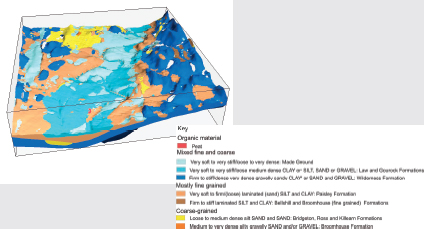
FIGURE 1 Example of three-dimensional engineering geological modeling employed by the British Geological Survey for visualizing variability in geologic materials and their physical properties. SOURCE: Reeves, 2010. Reproduced by permission of the British Geological Survey. © NERC. All rights reserved. CP12/073.
From a broad perspective, however, insufficient use is made of all the classification and material testing that is carried out on the thousands of individual projects that occur in a medium- to large-sized city every year. Collection and integration of such data remain difficult because, to be useful, the data must be carefully documented and referenced as to location, depth, other properties, and pedigree (e.g., data sources, what tests were run, and was test equipment properly calibrated). Also, and perhaps the most telling, are the significant disincentives for project owners and their consultants to release data because of concerns related to liability and loss of proprietary knowledge. Nevertheless, regulations exist, for example, that require well boring operations to submit their boring logs to state geological surveys. Steps to usefully capture more of the geotechnical
views of data can enhance decision making and help to quantify uncertainties that historically are a source of difficulties in contracting and litigation. Confidence maps can be created based on data density and geologic complexity that indicate areas of low or high uncertainty in models (see Figure 2). Given variability of geologic conditions and the spatial limitations of underground characterization tools, information about the underground is often limited and includes significant uncertainties.
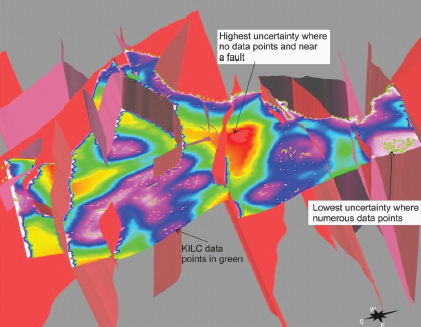
FIGURE 2 A bedrock confidence map produced for an area in Glasgow, Scotland. The green points represent actual data points; the roughly vertical planes represent faults. Contours represent levels of uncertainty based on data density and geological complexity of modeled surface (red indicating high uncertainty). Such maps provide valuable insights regarding where more data may be needed. SOURCE: Reeves, 2010. Reproduced by permission of the British Geological Survey. © NERC. All rights reserved. CP12/073.
data generated represent important ways to help enable the sustainability of the urban underground and the regions it serves.
To move toward engineering practices that are consistent with such sustainability goals, data related to underground infrastructure development need to be archived in formats and with tools that make them retrievable and accessible for the infrastructure life cycle—and beyond (to account for infrastructure artifacts in place well after closure or decommissioning). These issues will be discussed in a later section related to the critical challenges of archiving infrastructure-related data.
Figure 6.5 Support categories estimated from the tunneling quality index (after Grimstad and Barton, 1993) SOURCE: Palmstrom and Broch, 2006.
Sustainability as an integral part of design is a relatively new concept. Sociopolitical and economic issues, discussed in earlier chapters, influence infrastructure design, perhaps at the expense of sustainability. Design and analysis of underground infrastructure is often heavily focused on the immediate opening and support of underground space; long-term issues related to sustainable maintenance and use are often overlooked, as are lifecycle contributions of the infrastructure to society. Project constraints such as rights of way and access can impact selection of project alignment, and physical constraints such as those associated with water conveyance gravity systems (e.g., slope, number of lift stations, length of drives), maximum grade (for construction and operation), and shaft location also may affect design choices. New technologies or policies that reduce the adverse affects of such physical constraints could reduce the cost of
developing underground space.2 As discussed in Chapter 4, codes and standards guide design and operation, especially where public safety is affected. Although building codes can protect the health and safety of those constructing, operating, or using infrastructure, building codes are static in nature and, therefore, can detract from sustainability goals and leave little room for flexibility or evolution of technologies.
Constraints created by the limitation of design tools, or by the limitations of those who use the tools, also limit the ability to design underground infrastructure optimally and to reduce lifecycle costs. Underground infrastructure design can benefit from iterative analyses of designs—especially innovative designs—in a virtual environment. Design performance in difficult ground conditions can be predicted using numerical models, and results of analyses can inform infrastructure design modifications that meet constraints and desired parameters. The process can be repeated as often as necessary until desired model responses and optimal design are achieved. Commercial software packages are available for this sort of analysis, but their use is successful only if their limitations are recognized. Needed in geotechnical design is greater consistency in numerical modeling usage, project design validation, and integration of modeling with other analysis components (scaling) to arrive at more sustainable design. This requires software enhancement, especially with respect to graphical user interface interactions, error checking, and user training. Another challenge is the lack of appropriate ground behavior model input. Field and laboratory test data are often not appropriate for input in advanced analysis or model verification. Stronger and more direct linkages between field investigation data and model development are needed (e.g., Hashash et al., 2009).
The proper combination of technology, training, and skills are vital to good engineering design. The design of sustainable underground facilities is a complex and iterative process that is necessarily a team effort, as described in Chapter 3. Continuous communication between engineers, owners, and interested third parties is necessary to develop optimal designs that meet the owner’s specific requirements and societal sustainability goals. Input from a broader array of stakeholders helps create infrastructure that is integrated into the system of systems that comprise urban development. Designers need to contend with how the space fits within existing infrastructure, its long-term impacts on the total urban environment, and its resilience over time.
The next sections describe typical major inputs to the design of underground projects.
_______________________
2 An example of this is a Japanese law pertaining to the public right to space of greater than 40 m depth as a means to enhance planning and sustainability of underground resources. The laws allows rational choices for project alignments and preservation of the underground for future uses (Konda, 2003).
Integrating Design and Analysis
Good engineering design includes analysis of system performance as part of design development. Many tools are available to design details of underground structures—for example, thickness of supports or appropriate size and location of ventilation shafts. Empirical and analytical design methods, ideas and procedures based on experience, building codes, and analytical and computational software packages all contribute to optimal design of underground structures. However, their effectiveness directly correlates with the quality of data input and the knowledge base and experience of those applying the tools.
Experience
The lack of education and training that allows good engineering of underground systems is of growing concern in the United States and will ultimately affect the resilience of underground infrastructure and sustainability of the urban development. Fewer than five U.S. institutions of higher education provide student opportunities in underground construction, and engineering talent is being imported from overseas. Similarly, it is critical for the underground construction industry to develop mechanisms that allow the relevant transfer of experience from senior personnel to young engineers.
Empirical Design Tools
Empirical design methods rely on quasi-quantitative approaches to material characterization based largely on experience-driven judgments. They are not necessarily based on fundamental mechanisms of ground and structure behavior. For example, soil and rock classification systems are based on the comparison of observed material behaviors from the infrastructure site to similar observations made elsewhere. Behavior is predicted based on those comparisons, but the underlying reasons for the behaviors may not be well understood. Even so, the soil and rock classifications based on empirical characterization often inform support requirements and design specifications. In some cases, empirical characterization may be based on a large number of prior observations, and resulting conclusions may be robust. In other cases, few data exist to enable comparisons, and empirical characterizations may be more similar to “best guesses.” Empirically based conclusions can be considered first-order estimations, and further observations may be necessary to confirm or refine those estimates. In other words, they can be used to interpolate but not extrapolate. Improper use of empirical tools can result in safety hazards, poor performance, or unnecessary expenses. Educating professionals about the limitations of empirical methods is one way to improve their use. Improving the databases of observations and the methods for their expansion is another.
Analytical and Computational Methods
Analytical methods—primarily closed-form mathematical solutions that do not require the use of a computer—for calculating stresses, strains, ground movements, groundwater flow, and other properties are critical to improving the understanding of underground structure behavior in concert with the ground environment. They provide data on the responses of underground structures for particular idealized boundary conditions and material behaviors. Analytical methods are key tools for building knowledge and judgment regarding geotechnical behavior, for carrying out preliminary design studies (or full design given suitable configurations), and for comparing complex computational model outputs to gauge reliability. However, they cannot capture the full complexity of most underground structures and geological conditions.
Computational methods such as finite element, finite difference, and discrete element methods are used to estimate behaviors of soil, rock, or engineered structures when a sufficient amount of detailed information is available—for example, to refine design based on responses—but can be useful when there is limited prior experience working under specific conditions. Behaviors may be predicted using computer software programs. Computational methods may be used to estimate, for example, structure-ground interactions and deformations, changes in the ground environment (e.g., thermal changes and groundwater flow and contamination), and the propagation of fire and smoke in occupied underground spaces. All computational methods, whether based on discretization (e.g., differential versus integral) or continuity assumptions (e.g., continuum, discrete rock blocks, or some hybrid), require knowledge of spatial information and materials properties (e.g., intact materials, discontinuities, and fluid properties).
In many respects, the rapid development of computational methods during the past several decades has moved beyond present ability to gather sufficiently detailed data to populate the models or validate complex model output (e.g., behaviors) before model information is incorporated into design. The ability of a designer to compare the results of different analytical and simulation approaches and to access relevant case history data could be significantly enhanced. To benefit more fully from advances in computational methods, ground information models can be linked dynamically with data from excavation equipment, support systems, and updated simulations to provide useful feedback loops. The information can be used during construction to validate predictive models used in design, improve ground characterization, and update expected ground and structure responses. Similarly, data collection from the ground environment and the underground infrastructure itself throughout the infrastructure life cycle would enhance understanding of the sustainability implications of the structure (e.g., impacts to and from the surrounding environment). The United States has been the leader in the development of numerical simulation software for geotechnical engineering for several decades, but that lead is threatened by advances in
Analytical and Computational Model Development
More and better data are not enough. Better models are needed to investigate the behavior of complex adaptive and coupled infrastructure systems including
• analytical and computational models that predict and learn system performance, identify vulnerabilities, and provide a platform to investigate opportunities to increase security, robustness, resilience, capacity and efficiency, and cost-effectiveness;
• linkage elements and algorithms that allow simulation and exploration of cross-sector interactions and interdependencies; and
• tools to visualize and communicate the outputs of these advanced simulations.
Enhanced analytical techniques need to be applicable under routine operating conditions, and also need to capture emergent operating conditions and behaviors resulting from complex system interactions and non-routine internal or external stresses (e.g., earthquakes, major storms, sea level changes, terrorist activities).
Validated models could provide a platform to understand how best to
• integrate and operate above- and belowground infrastructure facilities for reliable and sustainable service provision;
• capture the potential of new technologies and materials to enhance performance of existing systems and to gain insight into the changing balances between centralized and decentralized system attributes;
• design and deploy sensing networks to efficiently and economically capture complex system behavior and improve system operation and security;
• develop long-duration research test beds for deployment of sensors in real environments;
• enable reliable data security for transmitted and stored data and develop resilient system architecture that can detect manipulated data; and
• explore new concepts in system design, operation, and maintenance that decrease vulnerability and provide flexibility and resilience.
simulation approaches in other countries. Multiple software packages now in use in geotechnical practice have been developed outside the United States. Box 6.2 describes some of the needs related to analytical and computational model development.
TECHNOLOGIES FOR UNDERGROUND CONSTRUCTION
Technological developments related to excavation, ground modification, improvement, support, tunnel boring, and use of excavated materials are important for developing underground space more efficiently, cost effectively, and
under increasingly difficult ground conditions. Underground technology development and engineering advances are spurred by underground construction requirements throughout the world (Parriaux et al., 2006), and by the need to remain competitive in an international market for underground construction contracts. The importance of underground infrastructure development that contributes to sustainable development is now being recognized (e.g., ECTP, 2005).
Sustainability of the urban environment is partially dependent on minimizing disruptions to economic output of populated areas during construction (and later maintenance) of underground infrastructure. Underground projects often take years to complete, and during that time equipment is moved to and from an excavation site and huge volumes of excavated soils and rock (muck) must be moved. Streets may be blocked for extended periods, and truck movement on surface streets can be disruptive and polluting. Because each project and environment is unique, no single engineering solution minimizes disruptions, use of nonrenewable resources, and costs for all underground projects. However, technologies are available if there is a willingness to incur additional startup expenses. Advances in technologies such as new tunnel boring machines (TBMs) and trenchless technologies can minimize disruption, for example by allowing excavation in difficult ground conditions without open trenching.
The next sections provide examples of technologies used in the construction of underground space, including cut-and-cover tunneling and excavation, tunneling and ground support in rock and soils, ground improvement, and monitoring.
Cut-and-Cover Tunneling and Excavation
Open-cut excavation is a common and well-proven technique for constructing shallow (e.g., less than 150 feet [50 meters] deep) tunnels, earth-covered buildings, and basements and building foundations. Utility excavation also commonly uses open-cut trenching. Even bored tunnels or immersed tube tunnel sections will use cut-and-cover tunneling for access, support structures, and launch of boring machines. Open-cut technologies may be economically optimal for areas with few constraints on surface use, but can be quite disruptive in populated areas.
Open-cut excavation can accommodate changes in tunnel width and nonuniform shape and is often adopted for the construction of chambers and stations. Selection among available construction techniques such as cast-in place, bottom-up, or top-down, depends on ground conditions, available space, and environmental requirements (for example, Bickel et al., 1996). Excavations are normally braced and open to the surface with subsequent backfill or continued vertical structure construction (see Figure 6.6). In public rights-of-way and when using top-down methods, the excavation may be covered at an early stage of construction to allow traffic flow to resume or to allow construction of the upper
FIGURE 6.6 Braced excavation for a cut and cover tunnel section of the Boston Central Artery. SOURCE: Y. Hashash.
floors of a building while the basement excavation is continuing. Cut and cover also can be used in submarine tunnels.
Major cut-and-cover projects in urban areas provide opportunities to update other underground facilities in their vicinity. For example, utilidors may be incorporated in transportation projects, and underground pedestrian networks in city center redevelopments (as occurred in both Montreal and Toronto) may be built. The direct and indirect comparative impacts of cut-and-cover construction in the public right-of-way as compared to less intrusive construction approaches such as bored tunnels and trenchless technologies are not always well enough understood to inform decision making.
Tunneling and Ground Support Technologies in Rock
Rock excavation is required for all types of underground uses including mountain tunnels, mining operations, and large underground caverns where rock is at or near the surface. In historic times, rock excavation was painfully slow, relying on hand tools or even thermal shock3 to disintegrate the rock. The introduction of blasting technologies in the sixteenth and seventeenth centuries revolutionized the speed of rock excavation and increased the range of projects that could be undertaken cost-effectively. In the past half-century, hard-rock TBMs have found widespread application creating medium length to long tunnels. Rock
_______________________
3 Fires were used to heat rocks, which were then quickly cooled with water. The rapid change in temperature caused rocks to crack and break. Broken rock could then be excavated.
excavation also benefited from the emergence of rock mechanics as a distinct branch of geotechnical engineering in the 1950s. Study of rock fragmentation, understanding of the post-peak strength behavior of rocks, and characterization of the influence of rock discontinuities on rock mass behavior are among the important outcomes from research in rock mechanics.
Drill and Blast Technologies
In drill and blast excavation, explosives and timed detonators are placed into drilled holes, the blast is carried out, the opening is ventilated, waste spoil is transported away from the excavation face, and the process starts again until the desired opening is obtained (e.g., Sellers et al., 2010). Blasting is typically the preferred solution from a cost perspective for short rock tunnels and for the excavation of foundations and rock caverns. Blasting, however, can be especially challenging in urban environments given higher amplitude vibrations (and therefore, ground shaking), larger sized spoil material, and a greater need for primary tunnel support than, for example, that result from TBM use. Excavation speeds are relatively slow, the process is noisy, and overbreak (excavation of too much material) is possible.
Alternatives to conventional drill and blast technologies are possible. For example, propagating fractures from boreholes in rock using controlled gas expansion could allow continuous excavation without releasing the excess energy that causes vibration and flying rock. The commercial application of such technologies so far has been restricted to specialized applications where conventional blasting is not feasible.
Blast design (e.g., blast patterns and sequences) could be more effective with improved computational models of drilling, blasting, vibrations, and displacements. Designs that minimize noise and vibration, for example, may allow blasting at any time of day, increasing productivity, minimizing disruptions to local neighborhoods, and minimizing damage to surrounding infrastructure. As cities become more densely developed and use more underground space, blasting approaches that are proven to minimize damage and nuisance will be desired.
Tunnel Boring Machine Technologies for Rock Excavation
Early variations of TBMs for soft rock were developed in the late 1800s (e.g., the Beaumont English boring machine was used on one of the early attempts to create the Channel Tunnel between England and France; Maidl et al., 2008). Early advances in TBM design were made by the Robbins Company of Seattle, Washington, which remained the world-wide leader in TBM design and manufacture for many decades. During the past decade, however, TBM manufacture has become increasingly dominated by non-U.S. companies.
Machine tunneling in harder rock remained a challenge because of inefficiencies and rapid wear of the pick-type rock cutters in use at the time. With the advent of full-face machine design and disc cutters for rock and proof of the
value of the TBM approach (e.g., the Chicago Tunnel and Reservoir Plan), the hard-rock TBM using disk cutters gradually supplanted drill and blast technologies for longer tunnels.
Advance rates using TBMs in soft rock can exceed 100 ft per day. However, tunnel excavation is a systematic and industrial production process that can only proceed at the speed of the slowest element in the system. Thus, technological advances that increased the speed of rock fragmentation could not be fully applied until the muck conveying systems that remove excavated materials could be designed to keep pace. Advance rates for rock excavation also could be improved with more efficient methods of installing supports and reinforcements. Ground control measures to prevent loss of confinement and therefore face instability, chimneys,4 cutterhead blockage, and tunnel collapse in blocky and highly fractured ground could be improved. Improved methods for predicting and mitigating spontaneous, energetic, and sometimes hazardous rock fracture (rock-bursts) in highly stressed competent rock could minimize risk and result in more repeatable construction practices, more consistent work products, and better control of construction times and costs. This parallels a need for fundamental advancements in our understanding of rock mechanics and rock behavior, including three-dimensional rock fracture mechanics.
With better quantification of rock and excavation tool interactions, there can be increased use of systems that sense their own progress and functioning (smart systems), more automation in underground construction (e.g., robotics) to reduce risk to workers, and enhanced ability to probe ahead of the excavated face to detect changes in material properties. Modern TBMs are computer-controlled, high-tech machines that use laser guidance systems and sensors to obtain realtime information on system performance. Data obtained during excavation can be used in feedback loops to optimally adjust, for example, thrust and rotation speeds.
Tunneling and Ground Support Technologies in Soil
Indurated rock may be more difficult to fragment while tunneling, but tunneling in soils (unconsolidated materials) presents challenges related to ground support, muck removal, and excavation-induced effects on the surrounding ground (e.g., ground settlement, lowering of the groundwater table). Improving control of deformation due to tunneling in soil is a key to limiting damage to existing infrastructure and improving capacity to sustainably develop underground space in most urban areas.
Tunnel lining is also an area where efficiencies can promote sustainability. Costs, for example, may be reduced when initial and permanent support (e.g.,
_______________________
4 Vertical openings from the tunnel to the surface created as a result of displacement of material into the tunnel.
construction support and final lining) are integrated, or when thicknesses of linings are reduced through use of new higher-strength materials. Other beneficial advances could include enhancing techniques to decrease overcut during mining, improving directional control during mining to decrease the allowances for alignment errors, and developing more efficient and rapidly deployed formwork for cast-in-place linings.
Tunnel Boring Machines in Soil
Recent technological developments for tunneling in soil include the earth pressure balanced TBM (see Figure 6.2) and the slurry shield TBM (Figure 6.3). These simultaneously excavate and support a tunnel face by creating a separate chamber (bulkhead) that closes off the face from the rest of the tunnel. These advanced technologies greatly mitigate risks of tunneling in saturated soils including those associated with running soils at the face, significant settlement in poor ground, and excessive water pressure. In the past, machine tunneling was not possible for deep tunnels under high water pressures without the use of compressed air in the tunnel—an expensive process with significant safety and risk issues. Comparatively, the earth pressure and slurry technologies greatly minimize settlement and associated damage, increase excavation speeds, and reduce costs. As a result, increasingly larger tunnels have become safe and economical to construct in poor soil conditions and allow such tunneling to contribute to more sustainable solutions for transportation and other infrastructure needs.
Sequential Excavation Methods
Sequential excavation methods (SEM) include multiple applications such as the New Austrian Tunneling Method and the Sprayed Concrete Lining Method that rely on integrating the excavated rock or soil into the tunnels’ supporting structure (FHWA, 2009). SEM design includes deliberately relieving stress by mobilizing the ground around a tunnel to the maximum extent possible through controlled deformation. The methods involve commitment to both a design philosophy and a construction method largely dependent on the observational method. Initial primary support of the tunnel is designed with consideration for load-deformation characteristics appropriate to existing ground conditions; the required installation speed is based on the magnitude and speed at which ground deformations develop. The primary lining provides initial support during construction, preventing roof collapse. Instrumentation is installed to monitor deformations in the initial support system and to inform of changes needed in the support design and excavation sequence. The tunnel is sequentially excavated and supported, and the excavation sequences can be varied. The permanent support is usually (but not always) a cast-in-place concrete lining. SEM can be applied in both shallow and deep excavations, but in either case the effects of deformation on surrounding structures and the surface need to be considered.
Ground support in SEM can be selected or optimized in real time to match
the ground conditions uncovered during excavation. This feature is intended to support the least favorable conditions encountered in the alignment and is in contrast to a pre-selected support system that does not accommodate variation in conditions along an alignment. The amount and the cost of materials needed for ground support can thus be reduced. However, the approach has its limitations: continuously changing the support scheme may reduce construction crew productivity and delay project construction. Further, the decision processes used in SEM are dependent on information that is not readily available (e.g., as related to ground condition, ground response, and movement). Research is needed in these areas to improve SEM application and contribution to more sustainable underground space development.
Trenchless Technologies
Many new underground utility construction and repair technologies have emerged in the past 40 years that allow installation, replacement, or repair of underground utilities or conduits without excavating a continuous trench from the surface. Although “trenchless” also applies to larger bored tunnels, the term typically refers to urban-utility-scale technologies rather than to rail, metro, or road tunnel installations. Trenchless technologies introduce new solutions for minimizing surface disruptions into short and long-term planning, design, and operation of underground systems. This will be especially true as the techniques become more commonly used.
Descriptions of trenchless technologies can be found in books and reports (e.g., Kramer et al., 1992; Thompson, 1993; Stein, 2002, 2005; Najafi and Gokhale, 2005), multiple conference proceedings (e.g., ISTT, 2010), journals (e.g., Broch et al., 1986), and magazines.5,6 Figure 6.7 illustrates major trenchless technologies and applications. Because many technological advancements have centered on better equipment or new processes, complete understanding of the processes from a design and application perspective has lagged behind adoption in the field. Much information about the technologies is obtained directly from installation contractors, manufacturers, suppliers, or through trade associations. This potential lack of communication between engineering designers and construction contractors is problematic. In addition, the relatively new ability to install utilities at low cost beneath existing shallow utilities without major disruption to the utilities or traffic provides the ability—and even incentive—to deepen the existing spaghetti layout of utilities as pictured in Figure 1.6. However, this could interfere with future placement of major transportation or water and sewer infrastructure. In other words, such construction technologies heighten the need
_______________________
5Trenchless Technology, magazine published by Benjamin Media, Peninsula, Ohio.
6Underground Construction, magazine published by Oildom Publishing, Houston, Texas.
FIGURE 6.7 Slurry shield machine for the East Side Access Project, Queens, New York. (left) Assembly of two tunneling boring machines (TBM) and their trailing gear in the launch pit. (right) Closeup of the cutter head of the TBM. SOURCE: Y. Hashash.
to address long-term planning and the ability to choose the most sustainable and best uses of urban underground space.
Ground Improvement Technologies
It is often necessary or productive to temporarily or permanently change soil or groundwater properties during underground construction to ease facility design, construction, or operation. For example, ground freezing can temporarily turn a weak, saturated soil into a solid and nearly impermeable material; dewatering can ease construction problems both in terms of water flow and soil stability; and grouting can be used to stiffen or change the permeability of soils. Ground modification techniques and the development of new materials used for geoenvironmental and geomechanical applications (e.g., bio- and nanotechnologies; NRC, 2006) are active areas of research and field application. Furthering application of established methods (e.g., jet grouting and compensation grouting), as well as developing new approaches and materials, offer the potential for cost reductions and performance improvement. However, as for trenchless technologies, application of new ground improvement technologies may outstrip theoretical understanding of the methods, meaning that application of these techniques in design may not be optimized. Further research and development is needed to improve existing methods, enhance understanding of their application, and allow better engineering with, for example, in situ biotechnologies, nanotechnologies, and other ground improvement and remediation techniques that can reduce the
FIGURE 6.8 Major techniques grouped under “trenchless technologies.” CIPP designates cured-in-place pipe. SOURCE: Raymond Sterling. Reprinted with permission from the author.
resource use and be gentler on the environment than can more traditional construction methods.
Monitoring During Construction
Geotechnical and construction monitoring programs provide the basis for understanding ground response to excavation and the impacts of construction on existing structures and the natural environment. Monitoring for construction may be more intensive than monitoring for infrastructure operation, but it is usually of shorter duration (often less than five years). Monitoring instruments may be exposed to harsh conditions during construction and need to be more robust. Monitoring the behavior of the underground facility and surroundings during construction helps to ensure safety, assess performance, validate design, and inform necessary design changes. Figure 6.8, for example, shows the level of detail possible using laser scanning to monitor excavation progress. Changes in the image over time provide information about work progress but also could provide information about the effects of excavation on, for example, nearby infrastructure. Monitoring water volumes and pressures and water and air quality
FIGURE 6.9 Monitoring data is continuously fed back into enhanced design and construction. SOURCE: Modified from Hashash and Finno, 2008. Used with permission from ASCE, ©2008.
helps to protect groundwater resources and air quality above and below the surface. Contractors typically monitor and analyze construction processes and operations (e.g., shift utilization, equipment downtime, repair or replacement, ground support installation, muck volumes, and grout takes) to identify opportunities to improve efficiencies.7 Contractors also continuously monitor ground gases (e.g., methane, carbon monoxide, hydrogen sulfide) in excavations.
The use of sensors to measure geotechnical and structural displacements of individual structures, projects, or operations is well established in practice (for example, see Dunnicliff, 1993), and engineers continually improve their ability to use those technologies in ever more innovative ways. However, a major premise of this report is the need for a system of systems approach, which implies a need to create integrated systems that can monitor urban system conditions. Information regarding all elements of a system can be captured during all phases of their life cycles, allowing observation of the effects of changes observed in one system element on other system elements. Data from underground systems are expensive to collect as an isolated task, and hence it would be best to gather useful data whenever underground work provides such an opportunity. The past decade has seen a revolution in the developments of sensors, sensor technologies, and information technology infrastructure to allow integrated monitoring systems that provide timely feedback to designers. Figure 6.9 shows what such a feedback loop might look like.
Opportunities to advance construction monitoring include the means to collect and analyze detailed real-time monitoring data during construction
_______________________
7 This information is often considered the property of the contractor and is not necessarily shared with the owner.
FIGURE 6.10 Example of laser scanning to monitor excavation progress. Image courtesy of Y. Hashash.
equipment operation. For example, cutterhead operation data (e.g., torque, power, thrust, penetration per revolution, disc cutter forces, rotational speed, bearing temperature, and disc location) increase knowledge of excavation processes, in particular geologic conditions. In a similar manner, continuous measurement of the volume, weight, and advance rate of removed spoil is an important indicator of ground displacement and settlement control (see Box 6.3 for example). Benefits of doing this have been recognized for some time, but the ability to apply—by practical means—the data gathered is still emerging (for example, see Box 6.4). Other opportunities come from advances in surface imaging and image processing. Surface displacements of an entire excavation face over time, for example, can be recorded using photographic, laser-based, or alternative imaging systems (see Figure 6.7). Some geologic features can be automatically identified from the scans. Such visual data could be integrated with conventional numerical method data to develop as-built plans and specifications for archiving purposes.
As a general trend, advances in construction monitoring are moving away from physical measurements at a limited number of points, to widely distributed, wirelessly connected sensor networks, and to areal scanning techniques. These data allow contractors to optimize construction processes and increase safety on the job (see Figure 6.10). Integrating data from multiple projects can facilitate improved equipment design, performance prediction, and understanding of zonation and geologic material properties. Monitoring for enhanced safety is also becoming more critical as larger diameter and shallower infrastructure (e.g., tunnels and stations) facilities are increasingly proposed for urban sites.
TECHNOLOGIES FOR EFFECTIVE ASSET MANAGEMENT
The ability to operate and maintain underground infrastructure over the long term is essential to its sustainability and to that of the larger system to which it belongs. All built systems require and need to accommodate maintenance,
Construction Monitoring in the Crossrail Rail System, United Kingdom
A system of 21 km of twin-tube rail tunnels is being constructed under London (United Kingdom) to expand existing network rail systems.a Extensive real-time data monitoring and centralized data management are critical parts of risk control and the processes to, for example, monitor construction progress and control of land movement, surface settlement, and volume loss (Reynolds, 2010a,b). For example, to control extraction and coordinate lining build rates, a measurement system determines spoil extraction weight on the fixed spoil conveyor that runs along the TBM, and video and laser scanning of spoil on the conveyor is monitored as a supplemental (but less reliable) weighing method (Reynolds, 2010b). The Underground Construction Information Management System (UCIMS) brings together all data from geotechnical and construction instrumentation and monitoring into a centralized resource. Contracts may require probe hole drilling during excavation from which drilling rates and water inflow volumes and pressures can be evaluated and geologic problems can be forecast. In some cases, geophysical probing ahead of the excavation face has been used to predict problematic conditions.
__________________
especially those operated over decades or centuries. Maintaining underground infrastructure is, in some ways, analogous to maintaining an aging fleet of aircraft through use of nondestructive methods of evaluation and repair. Sustainable infrastructure systems need to be designed to allow flexibility and to accommodate rapidly changing technologies, new safety and health standards, and changing cultural needs and demands—in other words, sustainability is dependent on the ability to accommodate technological and social evolution. For example, underground conduits can be reused if their size, condition, and alignment fit new needs. Low-pressure manufactured gas systems can be converted to high-pressure natural gas systems, for example, by slip lining new pipes within the old. Existing underground piping systems of various kinds can be (and have been) adapted to deliver fiber optic connections to homes and businesses.
In the shorter term, operation and maintenance of underground infrastructure represents a sizable annual investment. Many forms of underground infrastructure are difficult or costly to inspect. Most underground piping, for example, does not allow person entry for direct inspection, and taking pressure pipes (e.g., for gas, oil, or water) out of service for inspection entails major disruptions and revenue loss. Underground rail infrastructure (especially highly used metro systems) present special challenges related to access for inspection and rehabilitation. Compared to other forms of underground infrastructure, road tunnels are probably well maintained because the interiors are readily visible—problems may be identified more quickly. Much underground infrastructure, however, can be
Networked Instrumentation for the Transbay Transit Center, San Francisco, California
The Transbay Transit Center (TTC; see http://transbaycenter.org) is a $2 billion project to replace the existing Transbay terminal in downtown San Francisco with a modern regional transit hub that will connect 11 regional and city transit systems and will be the terminus point for the High Speed Rail from Los Angeles. The construction of the TTC requires a 60-ft-deep, 185-ft-wide, and 1,500-ft-long open-cut excavation in relatively soft soils adjacent to several high-rise and low-rise buildings including one of the tallest buildings in San Francisco.
The excavation is unprecedented in scale on the U.S. West Coast and includes an extensive monitoring program to help minimize disruption to surrounding facilities. The project employs state-of-the-art in-place sensors placed at depth in the underlying soils, as well as on surrounding buildings, utilities, and other infrastructure (see Figure 1). The sensors measure the response of the soils and infrastructure to construction activities. Cameras are used to continuously capture construction images. Microphones immediately point cameras in the direction of sources of sudden noise. Data for all sensors and imaging equipment are streamed wirelessly into cloud storage and accessed from anywhere in the world via a password-protected, web-based interface called the Global Analyzer (see Figures 2 and 3). The Global Analyzer synthesizes all data streams and issues automated alerts via email and mobile text messaging should any of the instruments exceed pre-determined thresholds. This information is complemented by a Twitter feed whereby contractor personnel and design team engineers post brief descriptions of construction activities—thus developing a record of construction that can be later referenced.
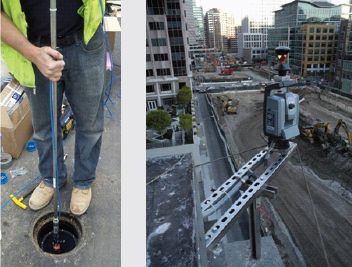
FIGURE 1 (Left) Placement of an in-place inclinometer with wireless networking. (Right) Automated total station with camera and dedicated wireless hotspot/node to continuously measure movements of targets placed on infrastructure around the site (Photos Courtesy of GeoInstruments).
FIGURE 2 The Global Analyzer cloud-based sensor data and documentation interface for the TTC. Designed and implemented by Arup North America Ltd. for Transbay Joint Powers Authority, San Francisco, California.
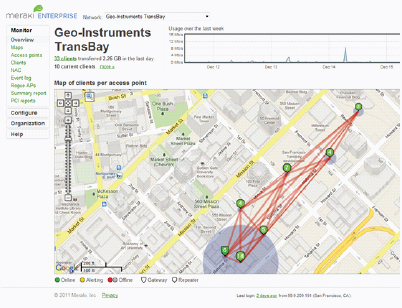
FIGURE 3 TTC project wireless network for live data and construction image transmission. Automated total stations, shown in green are used as wireless nodes for dedicated project wireless network. Designed and implemented by Arup North America Ltd. for Transbay Joint Powers Authority, San Francisco, California.
under-maintained for decades. Many deterioration, maintenance, and operational issues in underground facilities stem from, for example, groundwater intrusion into facilities or groundwater-induced corrosion of the facility structure. New materials for sealing underground structures or self-sealing of leaks or cracks would help to keep groundwater out of structures, and innovative design can incorporate drainage water into the aesthetic or energy concepts for the facility. It is also worth noting that improving asset management is not a question of just collecting more data—but of collecting worthwhile and cost-effective data that are then effectively analyzed to glean the useful information that guides decisions on maintenance, rehabilitation, and replacement.
Inadequate maintenance has lately received public attention thanks to various reports on the status of America’s infrastructure (e.g., ASCE, 2009). Increased attention to the problems caused by deteriorating infrastructure has resulted in some investment in improved technologies for inspection and rehabilitation. Much inspection work can now be done remotely using in-pipe robots, inspection “pigs,” or even free-floating devices that pass through pipes “listening” for leaks or gas pockets and that can provide information about flow rates and properties of the pipes such as the locations of valves and pipe joints.8 Remote fault detection through electrical and fiber optic cables can identify the position and nature of some defects. The concept of monitoring is taken even further with an increasing interest in “smart structures” (e.g., Wadhawan, 2007), in which wireless sensors are placed to monitor the structural health and long-term performance of various aspects of a structure. However, the challenges of use of sensors over decades remain formidable. The harsh environment in the underground can lead to their rapid deterioration in a relatively short period of time (e.g., Hoult et al., 2009; Stajano et al., 2010). Limited radio connectivity and power underground also can be a problem for wireless sensor networks (e.g., Bennett et al., 2010), and rapid technological developments in the wireless sensor field can render existing sensors nearly obsolete in less than a decade. Significant developments are needed in this area to fully achieve the vision of smart underground structures.
Addressing the immense maintenance deficit is vital for the sustainability of urban systems and requires a multifold approach. Significant incentives to invest in inspection, rehabilitation, and replacement of infrastructure, as well as to develop technologies that provide the cost-effective means to do so while minimizing disruption to city life and commerce, are necessary. New underground facilities must be designed and constructed with greater attention to lifecycle cost analyses (see Chapter 5) that account for modes of inspection and repair, sustainability, resilience, and end-of-useful-life considerations.
_______________________
8 One such device is manufactured by Pure Technologies Ltd. This device reportedly can be deployed in live pipes for up to 12 miles and detects leaks by emitting acoustic pulses transmitted to receivers attached to the pipe at known locations. The locations of leaks and air pockets are determined by analyzing the arrival times of the pulses at the receivers (Pure Technologies, 2012).
New technologies that reduce the costs of operation and maintenance of underground facilities, make them safer, and extend their useful lives could have a major impact on future costs and operational reliability of underground facilities. Basic research needs lie in better understanding of corrosion and other deterioration mechanisms both for in-use materials and for new materials and in the development of improved non-destructive testing approaches. Applied research needs include the continued improvement of inspection, assessment, rehabilitation, and replacement technologies—including ways to upgrade occupied underground facilities to meet current expectations of health, safety, and comfort. Better design and planning options for the reuse of existing urban infrastructure and creating multi-use options for the future (e.g., new design concepts for facilities that are easier to rehabilitate or retrofit for enhanced service life or repurposing) would also improve possibilities for sustainability.
Data Technologies
This section discusses broader issues of integrating underground system operations with the total infrastructural and social fabric of a region. When properly carried out, this integration can optimize facility use, ensure that operation and maintenance needs are met, and enhance delivery of societal expectations. For example, integrating underground and surface transportation systems can assure smooth flow of vehicles, occupants, and cargo for an entire region. Similarly, efficient wastewater conveyance tunnel systems operate in tandem with daily cycles of water use in a city. Situational awareness for development, operation, maintenance, and integrated management of urban systems is vital. Society is increasingly reliant on electronic, automated, remote, and networked sensor systems to monitor interactions and inform automated or human-in-the-loop decision systems; however, such data collection systems are not foolproof.
Varied sensor systems have been developed to measure a myriad of underground environmental and space functionality factors, all in an effort to inform decision making about underground operations and safety—for example in underground railroad systems (Bennett et al., 2010) and water distribution systems (Shinozuka et al., 2010). Factors such as air and water quality, noise level, traffic load, temperature, structural integrity of support systems, loose bolts in liners, corrosion of reinforced concrete, water seepage, traffic flow, control signals, and changes caused by extreme events (e.g., earthquake, explosion, fire) are among those that can be monitored. The ability to monitor such factors is vital to infrastructure sustainability and resilience, but current monitoring efforts cannot be applied widely enough to provide an adequate picture of the performance of a complete infrastructure system.
Because operational data transmission systems are considered “permanent,” there are incentives to invest in robust systems. Although sensor and supporting information technology infrastructure will be designed to require relatively
limited maintenance to the best of current ability, they also must be reliable and accurate, self-calibrating, small in size, reasonably priced, easy to operate and maintain, and upgraded at routine intervals. Sensor systems are expected to provide data around the clock for years and withstand dust, pollutants, moisture, and stray currents, and in the most useful case, provide immediate notification of failure. Sustainable systems require that failure of an individual sensor does not take down the entire system. Power to operate sensors must be obtained through replaceable power packs or remotely acquired when a measurement is taken (i.e., a passive sensor), or by “scavenging” energy from the sensor environment (e.g., local vibrations, fluid flow). Additionally, sensors need to be hardened against vandalism or accidental damage. The longevity of many sensor systems, however, is not known.
Data retrieval that allows real- or near real-time reception and data interpretation is important for operational decision making. Many of the same challenges that exist for transmitting construction data also exist for transmitting operational data. Hard-wired data transmission systems that require dedicated lines are reliable but can be costly (especially in long tunnels), and they are not suitable everywhere. The number of sensors employed is limited to how many sensors can be wired. The use of wireless data transmission has recently increased, driven by advances in wireless Internet protocol access, wireless local area networks (LANs), and the proliferation of cellular-based mobile phone services. Wireless data transmission avoids the cost of wiring, but data transmission deteriorates significantly in underground and confined spaces, especially in long tunnels. Wireless data transmission is vulnerable to security breaches that can compromise the system operation (Stajano et al., 2010). Location-based information (e.g., global positioning system [GPS] data) can provide locations of system elements needing repair, relay real-time information regarding conditions in underground space, and map locations of automated sensing and maintenance devices, but GPS and cellular signals are difficult to receive underground.
In addition to infrastructure operators, some underground infrastructure users (e.g., rail passengers) may rely heavily on location-based services and are accustomed to easy accessibility. Further development of location-based technologies that allow for seamless transition from aboveground to belowground may encourage underground use by those who do not want to lose that functionality. Further, real-time traveler information (e.g., arrival and departure information) on flat screens in small businesses within or near mass transit systems, or via text messaging and email alerts to mobile devices, could help to ease congestion in and around transit stations (Zhang et al., 2011).
Many other opportunities remain to develop new sensors and integrated systems for enhancing operation of underground transport systems. For example, technologies that employ security camera images for structural evaluation may prove beneficial. Selected trains or maintenance vehicles could be equipped with high speed cameras or laser scanners for periodic documentation of tunnel
conditions and compared using image reasoning algorithms to evaluate changes in structures.
Linking Data and Asset Management and Analytical Capabilities
Continuous streams of numerical and visual data can inform day-to-day operations, maintenance, and predictions of longer-term infrastructure performance and operations programs. However, interpreting the large streams of numerical and visual image data in real or near-real time can easily overwhelm human operators. Important information requiring action may be missed. Methods and automated systems to interpret these data and report problems to an operator would enhance optimal operation and maintenance of underground systems. Enhanced data management technologies can aid understanding of the performance of underground infrastructure as part of the larger urban system and allow planners to anticipate interdependencies and interferences that affect functionality and quality of service. Data management technologies such as Building Information Modeling (BIM) processes (e.g., Smith and Tardif, 2009) may make it possible to evaluate in greater detail the impact of new construction on existing systems installations, to evaluate the impact of existing systems on constructability of a new project, and to design sensing systems tailored for new and rehabilitated systems as part of an integrated urban system of systems. However, although these methods are extremely important, the technologies employed may become dated, and budget limitations make necessary data updates and accessibility challenging. Some data may need to remain secure. Private-public collaboration may be necessary to link, analyze, manage, and access system-wide data.
Systematic, standardized documentation of case histories related to underground infrastructure could help to expand fundamental understanding of excavation and support processes. Indeed, case histories are an important way to learn about the underground because they benchmark the state-of-practice, and provide information that may validate or disprove assumptions and models. Archiving of data and records associated with site characterization for infrastructure development, design, operation and maintenance, rehabilitation, reuse, and decommissioning would allow improved future planning and management in a manner that promotes sustainability long after the data are collected.
Information Security
Preserving, maintaining, and protecting data integrity against neglect, vandalism, time, or technological obsolescence are serious issues that threaten sustainable management. Capturing subsurface information is difficult enough; properly cataloging and maintaining it over long periods (e.g., 50 to 100 years and longer) is a significant challenge. Electronically archived data can become obsolete within just a decade or two when technologies change and the media
on which they are stored can no longer be accessed. On the other hand, paper hardcopies of data have survived for nearly a century for some tunnel projects, but only if properly cared for.
The security of data during transmission or storage in central computer systems is an increasingly serious concern. The data can be accessed, manipulated, and corrupted by unauthorized parties to the detriment of safe or smooth operation of underground facilities. Because sensor data inform decisions affecting, for example, life safety (e.g., traffic operations, ventilation), the well-being of underground infrastructure occupants depends on the secure and proper functioning of the system. The concern becomes more serious when sensors are used in automated feedback loops (such as traffic management or supervisory control and data acquisition [SCADA] systems). Data sabotage can immediately impact underground facility operations. The cause of the troubles may be hard to track down.
As use of networked sensing and automated decision making becomes more pervasive, there is a need to develop secure data networks and authentication mechanisms to prevent malicious or accidental data corruption and manipulation. The most hardened networks are still potentially vulnerable to malicious attacks, and the National Research Council (NRC) has published multiple reports on issues related to information technology security (e.g., NRC, 2010a,b). In 2007, the NRC developed a strategy for cyber security research and promoted categories of research that included limiting impacts of security compromise (e.g., the design of secure systems, evaluation of security), enabling accountability (e.g., attribution, remote authentication), promoting deployment of security designs (e.g., “usable security”), deterrence (e.g., legal policies and measures), and speculative, “out-of-the-box” approaches to security (NRC, 2007). Resilience needs to be built into sensor systems, including human-in-loop decision making for critical components to mitigate against corrupt data.
TECHNOLOGIES THAT PROMOTE SUSTAINABILITY AND RESILIENCE
This section draws attention to some key issues related to the sustainability and resilience impacts of underground facilities, and specifically to how technological developments could promote improvements in these areas. Many of these issues already are considered in some form in the design and operation of underground facilities, but they take on special importance when considered in light of overall community sustainability and resilience. Other issues, such as the understanding and control of highly interrelated systems of systems, represent new areas of study with great future importance. The interconnections and interdependencies between individual infrastructure systems and the overall functioning and well-being of the social community and systems need to be considered.
Improving the possibility of sustainability necessitates consideration of the economic use of materials. To be considered are the materials used, their resource availability, the processes needed to create construction-ready products, the long-term availability of the materials, the energy (and carbon footprint) implications of use, and long-term environmental impacts. For example, even commonly used materials such as sand and gravel may be in short supply because of a lack of regional availability or to urban development and planning decisions that render sand and gravel resources inaccessible. In terms of energy use (see next section), concrete, a significant element in most forms of underground construction, requires a high level of energy input for its creation (termed embodied energy). Some commonly used construction materials have been proven to be detrimental to the environment and public health (e.g., various types of volatile organic compounds used in pipes that can contaminate groundwater systems, and asbestos used in cement piping).
Excavated materials from some tunneling projects could prove to be a resource for nearby construction projects. Millions of cubic yards of material may need to be removed from an excavation. Some of this material could be a source of sand, gravel, and rock. Some of this material, however, may end up being classified as hazardous and therefore need special handling and disposal. Still, a large volume of material may be suitable for other construction uses, or may be part of the solution to other sustainability issues. Box 6.5 describes the case of the reuse of excavated materials from the Boston Central Artery/Tunnel project to help reclaim a solid waste facility and turn it into a park operated by the National Park Service. Disposal or reuse of excavated materials is a serious issue that warrants further attention.
More sustainable use of materials could mean choosing underground design and construction options that use smaller quantities of materials or materials with improved performance, or it could mean incorporating more waste or byproduct materials derived from other applications into design (e.g., geopolymers made principally from waste flyash). The lifecycle costs and benefits, however, need to be factored into decisions. For example, integrating primary (support for construction) and permanent ground support systems may allow for the use of less construction materials, but may affect the efficiency of construction operations. Maximizing the ability of the ground to be part of the support system, or reusing excavated materials from within or near a project, would help to increase efficiency in material use or reuse. New lining and underground construction technologies are needed that reduce material use and improve long-term facility performance. More informed decision making requires making available better information about the sustainability aspects of construction materials (e.g., availability, embodied energy) to the the designers.
Reuse of Excavated Materials from the Boston Central Artery/Tunnel Project
Spectacle Island in Boston (Massachusetts) Harbor is the site of a municipal solid waste facility in use until 1959. From 1959 until 1993, the landfill remained an uncapped source of leaching into Boston Harbor. Uncontaminated excavation material from Boston’s Central Artery/Tunnel (the Big Dig) project was used to stabilize slopes on the island and fill and cap the landfill to convert it to recreational use. Excavated material was transported in more than 4,400 barge loads to the island beginning in 1992 (Barnett and Chin, 1998) and was used to cap the landfill with a 2-foot clay cap (MassDOT, 2012). The cap created an impervious layer that would serve to keep precipitation from mixing with the wastes beneath and leaching into the harbor. Excavated fill was mixed with biosolids from several waste composting facilities in New England to create topsoil that was subsequently vegetated to keep the cap in place (NEBRA, 2012). Approximately 2,400 trees and 26,000 shrubs were planted on the fill (MassDOT, 2012). In 2006, a 114-acre park opened after 15 years of cleanup activities. The park is operated by the National Park Service and houses a visitor center, several miles of hiking trails, and a swimming beach (NPS, 2012).
Energy and Carbon
The cost, availability, security of supply, and climate impacts of energy use have received worldwide attention in recent years, and scientists and engineers have been working toward developing calculators of the energy embodied in a variety of infrastructure and geotechnical systems (e.g., Chester and Horvath, 2010; Hammond et al., 2011; Soga, 2011). Without such calculators, it is difficult to understand the true energy costs of underground infrastructure. The underground offers multiple options for promoting energy efficiency and ameliorating climate change that are described throughout the report, but there remain planning, design, construction, maintenance, and other sustainability challenges to be better understood or integrated into practice to maximize the energy savings of underground infrastructure. More efficient or alternative methods to excavation or concrete production—both energy-consuming processes—may result in greater energy efficiency during construction.
Underground space use requires significant quantities of energy for ventilation, temperature control, lighting, fire detection, and other systems throughout the life of underground facilities. Some advances allow greater efficiency, but higher installation costs could deter their adoption. Development of technologies and space configurations that increase the efficiency of these systems will benefit facility operators and society at large. Light fixtures that accept lower energy demand lamps have been designed and are being specified for some new tunnels and retrofits. Ventilation systems are designed to minimize smoke danger associated with a large-scale fire and therefore have much higher installed-energy demands than needed for everyday operation. Minimum requirements for periodic
ventilation system testing result in regular spikes in energy use. However, standards could be reviewed and changed to determine if less frequent or different testing methods can assure safe operation and thus reduce energy consumption over the life of the system. New technologies and processes that increase energy efficiency, and development of new and smaller space configurations that reduce the use of energy resources, will benefit facility operators and society at large.
Underground facilities can be constructed and used to conserve energy and create systems that achieve ground heat exchange with subsurface geologic materials in the urban underground. Important research on underground heat transfer issues began in the 1970s and 1980s (e.g., Geery, 1982; Bloomquist, 1999). Ground-coupled heat exchange systems have since grown in popularity in Europe (Sanner et al., 2003). However, they have not been used extensively in urban communities, and their long-term efficiencies when used in close proximity with each other have not been evaluated. Investigation of thermal effects and long-term impacts on both underground climate and underground space usage is warranted.
The use of lower temperature geothermal resources can help to reduce net emissions of greenhouse gases through the use of ground source heat pumps or similar heat exchange systems for heating or cooling structures and potable and nonpotable water for residential use. Such systems exchange heat from the earth to a structure in the winter, and vice versa in the summer, and in some cases, can be incorporated directly into the foundations of infrastructure. Although energy savings can be significant (DOE, 2012), there are environmental implications to be explored, including the selection of refrigerants (e.g., Forsén, 2005), and the long-term effects of potential ground temperature changes on aquifers and groundwater flow, chemistry, biota, and on underground infrastructure itself. Other subsurface use may become restricted in some areas because of the presence of a “forest” of geothermal boreholes.
The issues of energy and resource production and energy-related waste storage are not investigated in this report, but they are relevant in the context of underground engineering and sustainable development. Extraction of conventional energy and resources from below the surface could be made more efficient with improved excavation and extraction rates, for example. Oil and gas production from deep wells, coal mining, uranium mining, and more recently gas production from deep shale formations are all part of the complex interaction of the underground with our energy future. There is also interest in the use of carbon sequestration and other waste disposal technologies at relatively shallow depth. These technologies often generate intense public policy discussions about actual or possible environmental impacts and the relative merits of pursuing different policies for energy conservation or energy production. Often missing are the critical data and analyses in the public domain that properly assign benefits and liabilities to the various options that can appropriately inform critical future options regarding energy and climate.
Nontraditional energy sources could be better and more efficiently exploited with advances in underground engineering technologies. Geothermally active regions can be exploited, for example, by drilling into hot rocks and using the naturally high temperatures to produce steam and electric power (Duffield and Sass, 2003). Known conventional geothermal resources have the potential to produce approximately 9,000 MWe, and an additional mean power potential of 30,000 MWe are estimated from undiscovered sources (USGS, 2008). An estimated additional 518,000 MWe could potentially be generated from nonconventional geothermal methods including engineered geothermal systems (EGS) (USGS, 2008). Issues such as corrosion from the highly corrosive groundwater in geothermal fields have to be addressed. Similarly, long-term operation and maintenance issues are not well understood for EGS systems, especially given the high pressures and flow rates expected of EGS wells. Reliable high-temperature submersible pumps suitable for EGS development, for example, have been identified as a technology gap (DOE, 2008). Another major impediment to geothermal resource use is proximity of resources to where the power is needed.
ASCE (American Society of Civil Engineers). 2009. Report Card for America’s Infrastructure. Reston, VA: American Society of Civil Engineers [online]. Available: http://www.infrastructurereportcard.org/report-cards (accessed July 3, 2012).
Barnett, C.J., and K. Chin. 1998. Soil contamination assessment and characterization in urban tunneling. Pp. 79-86 in North American Tunneling ’98, L. Ozdemir, ed. Rotterdam, Netherlands: Balkema.
Barton, N.R., R. Lien, and J. Lunde. 1974. Engineering classification of rock masses for the design of tunnel support. Rock Mechanics and Rock Engineering. 6(4):189-236.
Bennett, P.J., K. Soga, I. Wassell, P. Fidler, K. Abe, Y. Kobayashi, and M. Vanicek. 2010. Wireless sensor networks for underground railway applications: Case studies in Prague and London. Smart Structures and Systems. 6(5-6):619-639.
Bickel, J.O., T.R. Kuesel, and E.H. King. 1996. Tunnel Engineering Handbook, 2nd Ed. New York: Chapman & Hall.
Bieniawski, Z.T. 1976. Rock mass classification in rock engineering. Pp. 96-106 in Exploration for Rock Engineering, Proceedings of the Symposium, November 1976, Johannesburg, Z.T. Bieniawski, ed. Cape Town: Balkema.
Bieniawski, Z.T. 1989. Engineering Rock Mass Classifications. New York: Wiley.
Bloomquist, R.G. 1999. Geothermal Heat Pumps Four Decades of Experience. GHC Bulletin (December): 13-18 [online]. Available: http://geoheat.oit.edu/bulletin/bull20-4/art3.pdf (accessed June 4, 2012).
Broch, E., R. Sterling, J. Zhao, and C. Rogers, eds. 1986. Tunnelling and Underground Space Technology. Oxford, UK: Elsevier Science.
Chester, M., and A. Horvath. 2010. Life-cycle assessment of high speed rail: The case of California. Environmental Research Letters. 5(1):014003.
DOE (U.S. Department of Energy). 2008. An Evaluation of Enhanced Geothermal Systems Technology. U.S. Department of Energy, Energy Efficiency and Renewable Energy [online]. Available: http://www1.eere.energy.gov/geothermal/pdfs/evaluation_egs_tech_2008.pdf (accessed July 6, 2012).
DOE. 2012. Geothermal Heat Pumps [online]. Available: http://www1.eere.energy.gov/geothermal/heatpumps.html (accessed July 6, 2012).
Duffield, W.A., and J.H. Sass. 2003. Geothermal Energy—Clean Power from the Earth’s Heat. USGS Circular 1249 [online]. Available: http://pubs.usgs.gov/circ/2004/c1249/ (accessed July 10, 2012).
Dunnicliff, J. 1993. Geotechnical Instrumentation for Monitoring Field Performance, 2nd Ed. New York: John Wiley & Son.
ECTP (European Construction Technology Platform). 2005. Strategic Research Agenda for the European Underground Construction Sector, Draft, October 2005. European Construction Technology Platform [online]. Available: http://www.ectp.org/documentation/FA-UndergroundConstructions_SRA-VISION2030-23Nov05.pdf (accessed May 2, 2012).
El Salam, M.E.A. 2002. Construction of underground works and tunnels in ancient Egypt. Tunnelling and Underground Space Technology. 17(3):295-304.
FHWA (Federal Highway Administration). 2009. Technical Manual for Design and Construction of Road Tunnels-Civil Elements. Publication No. FHWA-NHI-10-034. U.S. Department of Transportation, Federal Highway Administration [online]. Available: http://www.fhwa.dot.gov/bridge/tunnel/pubs/nhi09010/tunnel_manual.pdf (accessed July 10, 2012).
Forsén, M. 2005. Heat Pumps: Technology and Environmental Impact July 2005: Part 1. Swedish Heat Pump Association [online]. Available: http://ec.europa.eu/environment/ecolabel/about_ecolabel/reports/hp_tech_env_impact_aug2005.pdf (accessed July 6, 2012).
Geery, D. 1982. Solar Greenhouses: Underground. Blue Ridge Summit, PA: Tab Books.
Grimstad, E., and N. Barton. 1993. Updating the Q-System for NMT. Pp. 46-66 in Proceedings of International Symposium on Sprayed Concrete - Modern Use of Wet Mix Sprayed Concrete for Underground Support, Fagernes. Oslo: Norwegian Concrete Association (as cited in Palmstrom and Broch, 2006).
Hammond, G., C. Jones, F. Lowrie, and P. Tse. 2011. Embodied Carbon: The Inventory of Carbon and Energy. A BSRIA (Building Services Research and Information Association) Guide BG 10/2011. Bracknell: BSRIA.
Hashash, Y.M.A., and R.J. Finno. 2008. Development of new integrated tools for predicting, monitoring and controlling ground movement due to excavations. ASCE Practice Periodical on Structural Design and Construction 13(1):4-10.
Hashash, Y.M.A., Q. Fu, J. Ghaboussi, P.V. Lade, and C. Saucier. 2009. Inverse analysis- based interpretation of sand behavior from triaxial compression tests subjected to full end restraint. Canadian Geotechnical Journal. 46(7):768-791.
Hoek, E. 1994. Strength of rock and rock masses. ISRM News Journal 2(2):4-16.
Hoult, N., P.J. Bennet, I. Stoianov, P. Fidler, C. Maksimovic, C. Middleton, N. Graham, and K. Soga. 2009. Wireless sensor networks: Creating ‘Smart Infrastructure.” Proceedings of the Institute for Civil Engineering - Civil Engineering. 162(3):136-143.
IMWS (Institute for Mechanics of Materials and Structures). 2009. Artificial Ground Freezing as Temporary Support in Underground Excavation. Institute for Mechanics of Materials and Structures, Vienna, Austria [online]. Available: http://www.imws.tuwien.ac.at/en/research/researchprojects/alte-projekte/artificial-ground-freezing.html (accessed July 23, 2012).
Institution of Civil Engineers (Great Britain). 1996. The observational method in geotechnical engineering. London New York, NY, Thomas Telford: American Society of Civil Engineers [U.S. distributor].
ISTT (International Society for Trenchless Technology). 2010. 28th International No-Dig Conference and Exhibition 2010, November 8-10, 2010, Singapore. Alexandria, VA: ISTT.
Konda, T. 2003. Reclaiming the underground space of large cities in Japan. Pp. 13-23 in (Re)Claiming the Underground Space, J. Saveur, ed. Lisse, The Netherlands: A.A. Balkema.
Kramer, S.R., W.J. McDonald, and J.C. Thompson. 1992. An Introduction to Trenchless Technology. New York: Van Nostrand Reinhold. 223 pp.
Maidl, B., L. Schmid, V. Ritz, and M. Herrenknecht. 2008. Hardrock Tunnel Boring Machines. Berlin: Ernst and Sohn.
MassDOT (Massachusetts Department of Transportation). 2012. The Big Dig: Facts and Figures [online]. Available: http://www.massdot.state.ma.us/highway/TheBigDig/FactsFigures.aspx (accessed July 5, 2012).
Muir Wood, A.M., A.M.M. Wood, and M.I. Brunel. 1994. The Thames Tunnel 1825-1843: Where shield tunneling began. Proceedings of the Institution of Civil Engineers – Civil Engineering. 102(3):130-139.
Najafi, M., and S.B. Gokhale. 2005. Trenchless Technology: Pipeline and Utility Design Construction and Renewal. New York: McGraw Hill.
NEBRA (New England Biosolids and Residuals Association). 2012. Putting Biosolids to Use: Spectacle Island, Boston Harbor [online]. Available: http://www.biosolids.com/Headlines/pdf/NEBRACaseStudySpectaclIsl01.pdf (accessed July 5, 2012).
Nicholson, D., C.M. Tse, and C. Penny. 1999. The Observational Method in Ground Engineering—Principles and Applications. Report 185, CIRIA, London.
NPS (National Park Service). 2012. Island Facts: Spectacle Island. Boston Harbor Islands National Recreation Area [online]. Available: http://www.nps.gov/boha/historyculture/facts-spec.htm (accessed July 5, 2012).
NRC (National Research Council). 2006. Geological and Geotechnical Engineering in the New Millennium. Washington, DC: The National Academies Press.
NRC. 2007. Toward a Safer and More Secure Cyberspace. Washington, DC: The National Academies Press.
NRC. 2010a. Toward Better Usability, Security, and Privacy of Information Technology: A Report of a Workshop. Washington, DC: The National Academies Press.
NRC. 2010b. Wireless Technology Prospects and Policy Options. Washington, DC: The National Academies Press.
NRC. 2012. Induced Seismicity Potential in Energy Technologies. Washington, DC: The National Academies Press.
Palmstrom, A., and E. Broch. 2006. Use and misuse of rock mass classification systems with particular reference to the Q-system. Tunnelling and Underground Space Technology. 21(6):575-593.
Parriaux, A., L. Tacher, V. Kaufmann, and P. Blunier. 2006. Underground Resources and Sustainable Development in Urban Areas. Paper No. 700. IAEG 2006 Engineering Geology for Tomorrow’s Cities: 10th International Congress of the International Association for Engineering Geology and the Environment, September, 6-10, 2006, Nottingham [online]. Available: http://www.iaeg.info/iaeg2006/PAPERS/IAEG_700.PDF (accessed July 10, 2012).
Peck, R.B. 1969. Advantages and limitations of the observational method in applied soil mechanics. Géotechnique 19(1):171-187.
Pure Technologies. 2012. SmartBall ® for Water and Wastewater Pipelines [online]. Available: http://www.puretechltd.com/products/smartball/smartball_leak_detection.shtml (accessed July 3, 2012).
Reeves, H. 2010. Attributed 3D Geologic Models in the UK and Their Application to Planning and the Sustainable Development of Underground Space. Presentation at the First Meeting on Underground Engineering for Sustainable Underground Development, June 1, 2010, Washington, DC. Reynolds, P. 2010a. Monitoring Contract for Crossrail. TunnelTalk: Direct by Design, June 2010 [online]. Available: http://tunneltalk.com/Crossrail-Jun10-Monitoring-contract-award.php (accessed July 2, 2012).
Reynolds, P. 2010b. Settlement Control Measures. Crossrail Geotechnical Series 3: TunnelTalk: Direct by Design, August, 2010 [online]. Available: http://tunneltalk.com/Crossrail-Aug10-Settlement-control-measures.php (accessed July 2, 2012).
Sanner, B., C. Karytsas, D. Mendrinos, and L. Rybach. 2003. Current status of ground source heat pumps and underground thermal energy storage in Europe. Geothermics 32(4-6):579-588.
Schmidt, B.S., and Y.M.A. Hashash. 1998. Seismic rehabilitation of two immersed tube tunnels. Pp. 581-586 in Tunnels and Metropolises: Proceedings of the World Tunnel Congress ‘98, April 25-30, 1998, Sao Paulo, Brazil, A. Negro, and A.A. Ferreira, eds. Rotterdam: Balkema.
Sellers, E.J., M. Kotze, L. Dipenaar, and M. Ruest. 2010. Large scale concrete cube blasts for HSBM model. Pp. 389-398 in Rock Fragmentation by Blasting, J.A. Sanchidrian, ed. London: Taylor and Francis [online]. Available: http://www.aelminingservices.com/pdfs/whitepapers/AEL-white-paper-on-Rock-Fragmentation-by-Blasting.pdf (accessed July 10, 2012).
Shinozuka, M., D. Karmakar, P.H. Chou, S. Kim, H.R. Kim, and L. Fei. 2010. Non-invasive acceleration-based methodology for damage detection and assessment of water distribution system. Smart Structures and Systems. 6(5-6):545-559.
Skempton, A.W., and M.M. Chrimes. 1994. Thames Tunnel: Geology, site investigation and geotechnical problems. Geotechnique 44(2):191-216.
Smith, D.K., and M. Tardif. 2009. Building Information Modeling: A Strategic Guide for Architects, Engineers, and Real Estate Asset Managers. Hoboken, NJ: John Wiley & Sons.
Soga, K. 2011. Embodied energy and gas emissions of geotechnical infrastructure. Pp. 59- 74 in Geotechnics and Earthquake Geotechnics Towards Global Sustainability Vol. 15, S. Iai, ed. Dordrecht: Springer.
Stajano, F., N. Hoult, I. Wassell, P. Bennett, C. Middleton, and K. Soga. 2010. Smart bridges, smart tunnels: Transforming wireless sensor networks from research prototypes into robust engineering infrastructure. Ad Hoc Networks 8(8):872-888.
Stein, D. 2002. Technical Information System: Rehabilitation and Maintenance of Drains and Sewers. Berlin: Ernst & Sohn.
Stein, D. 2005. Trenchless Technology for Installation of Cables and Pipelines. Bochum: Stein & Partners.
Sterling, R.L., J. Anspach, E. Allouche, and J. Simicevic. 2009. Encouraging Innovation in Locating and Characterization Underground Utilities. Report S2-R01-RW. Transportation Research Board [online]. Available: http://onlinepubs.trb.org/onlinepubs/shrp2/shrp2_S2-R01-RW.pdf (accessed July 10, 2012).
Thompson, J. 1993. Pipejacking and Microtunnelling. London: Chapman & Hall. 227 pp.
USGS (U.S. Geological Survey). 2008. Assessment of Moderate- and High-Temperature Geothermal Resources of the United States. Fact Sheet 2008-3082 [online]. Available: http://pubs.usgs.gov/fs/2008/3082/pdf/fs2008-3082.pdf (accessed July 6, 2012).
Wadhawan, V.K. 2007. Smart Structures: Blurring the Distinction between the Living and the Nonliving. Monographs of the Physics and Chemistry of Materials No. 65. New York: Oxford University Press.
Zhang, L., J.Q. Li, K. Zhou, S. Datta Gupta, M. Li, W. Zhang, M.A. Miller, and J.A. Misener. 2011. Design and Implementation of Traveler Information Tool with Integrated Real-Time Transit Information and Multimodal Trip Planning. Paper #11-2383. Transportation Research Board Annual Meeting 2011[online]. Available: http://pubsindex.trb.org/view.aspx?id=1092445 (accessed August 1, 2011).

